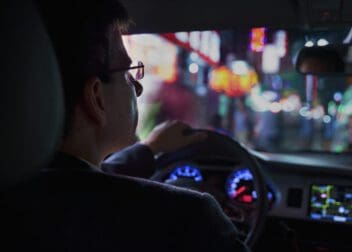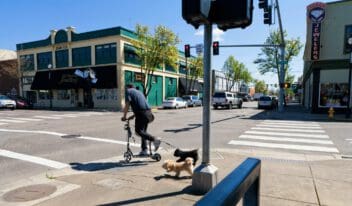Washington Driving Vision Requirements
Home / Vision Education Center / Vision & Vision Loss Impacts on Driving /
Last Updated:
In the state of Washington, you need to have an acuity standard of at least a 20/40 to drive with an unrestricted driver’s license. This is best corrected visual acuity (BCVA), which means you can use corrective eyewear to get your eyesight to at least 20/40.
Table of Contents
Vision acuity is vision clarity or sharpness. If you have 20/20 vision, that means you have normal visual acuity, the American Optometric Association (AOA) explains.
If your visual acuity is worse than 20/40, even with corrective lenses, you will be issued a Certificate of Visual Examination and be subject to a restricted license if a vision specialist is unable to correct your vision to the necessary 20/40 BCVA. You can be then be issued a vision recertification or referred for a reexamination to determine potential restrictions.
For a license renewal, you will need to certify that your vision is within the approved range.
Visual Acuity for Driving Unrestricted

To get a driver’s license in the state of Washington, you will need to:
- Be of legal driving age, which is 16 years old.
- Pass a written knowledge exam.
- Pass a driving test with a licensed tester.
- Pass a complete vision screening.
You deserve clear vision. We can help.
With 135+ locations and over 2.5 million procedures performed, our board-certified eye surgeons deliver results you can trust.
Your journey to better vision starts here.
The visual acuity standard for an unrestricted driver’s license in Washington is 20/40 BCVA based on the Snellen eye chart. The initial vision test is performed by the Washington State Department of Licensing (DOL). If you wear glasses or contacts regularly or to drive, you can use them for this test.
Both eyes are tested together and then separately for visual acuity, color, horizontal field, and color. Your horizontal field of vision needs to be at least 55 degrees with one eye or 110 degrees with both eyes. If you have bioptic lenses, you will need to take the vision test without using a bioptic telescope.
Restricted Driving License
If you fail the vision screening test, you are issued a Certificate of Visual Examination. You will then need to take this to an ophthalmologist or optometrist who will examine your eyes and offer corrective lenses if necessary. If you are not able to correct your vision to at least 20/40 BCVA, you may not be able to get a driver’s license without restrictions.
When your eyesight is not correctible to at least 20/100 BCVA, you are not eligible for a driver’s license in the state of Washington. You are deemed not qualified to drive. This is considered a failure of the driver’s license examination.
If your visual acuity is 20/70 BCVA or worse, you can be given a restricted driving license that only allows you to drive during daylight hours and not at night. When wearing corrective lenses to bring your vision to the minimum 20/40 BCVA, you will have a restriction on your license stating the need for corrective lenses.
In the case of a medical certificate, which states that there are visual or physical impairments, you can be issued a restricted license that specifies geographic areas, equipment use, distance, and/ or route restrictions. Restricted licenses are often issued based on specific circumstances set forth by the Washington DOL.
You deserve clear vision. We can help.
With 135+ locations and over 2.5 million procedures performed, our board-certified eye surgeons deliver results you can trust.
Your journey to better vision starts here.
Recertification & Reexamination

If you need recertification, you must see a trained eye care professional, and they must complete and return your Certificate of Visual Examination if you can achieve 20/40 or better BCVA with corrective lenses. You can then be issued a driver’s license with a corrective lens restriction. The visual examination will need to be current, within the past three months, to count.
The vision care professional may indicate that you will require periodic vision exams to ensure that your vision remains within the approved range or a new prescription will be issued to keep you in the approved visual acuity range.
When this is the case, new Certificates of Visual Examinations and often new medical certificates are issued on a specific schedule. You will then need to have these completed by your optometrist or ophthalmologist after completing a new visual exam. The certificates are then returned to the licenser in order for a driver’s license to remain active or be reissued or renewed.
If your visual acuity is still between 20/50 BCVA and 20/80 BCVA, you will be referred for a reexamination. When vision is worse than 20/80 or you use bioptic lenses, you are referred for a special examination.
Medical or visual conditions that have the potential to make night driving difficult can require a driver to be referred for a reexamination that will necessitate both a night and a day driving test. If your visual field is less than 110 degrees, you will also be referred for reexamination.
License Renewal
You can still get a license to drive in the state of Washington if you are able to pass the visual exam and or the driving test after the reexamination. When applying for a license renewal, you will need to pass a quick vision acuity test and not the complete visual examination that is done for the issuance of the initial license, special examinations, or reexaminations.
When applying for a renewal online or by mail, you will need to certify that your visual acuity is at least 20/40, either with or without visual corrections, and that you do not have any other vision problems.
You deserve clear vision. We can help.
With 135+ locations and over 2.5 million procedures performed, our board-certified eye surgeons deliver results you can trust.
Your journey to better vision starts here.
References
- Visual Acuity. American Optometric Association (AOA).
- Vision Test. Washington State Legislature.
- Washington. National Highway Traffic Safety Association (NHTSA).
- State Vision Screening and Standards for License to Drive. (April 2020). Prevent Blindness.
This content is for informational purposes only. It may have been reviewed by a licensed physician, but is not intended to serve as a substitute for professional medical advice. Always consult your healthcare provider with any health concerns. For more, read our Privacy Policy and Editorial Policy.
